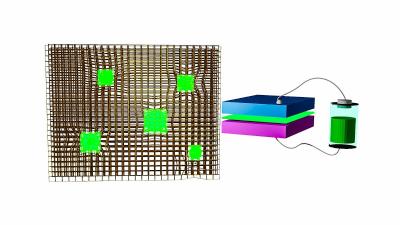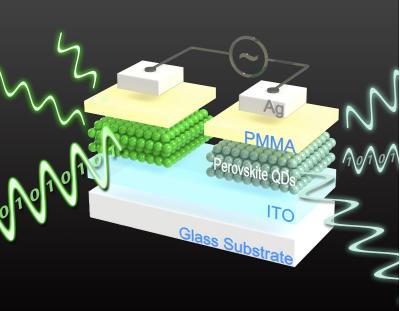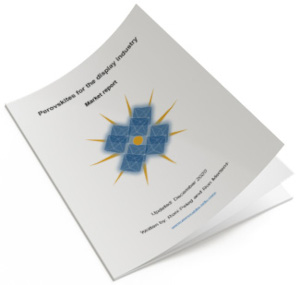Perovskite LED - Page 7
Researchers review ways to process transparent electrodes without causing damage to perovskite solar cells
A research team led by Erkan Aydin and Stefaan De Wolf from the KAUST Solar Center, along with co-authors from Turkey, the Netherlands and Spain, has presented an overview on the process of stopping damage from occurring to devices during the creation of transparent electrodes, particularly for a technique known as sputtering.
Damage from adding electrical contacts to sensitive semiconductors, including perovskites, can be mitigated using a buffer layer and optimized deposition. The new review gives a comprehensive overview for the origin and mitigation strategies for this technological problem.
Researchers develop perovskite-based 'unbreakable' glass for displays, lighting and more
A collaborative research team that included scientists from the University of Queensland (UO), the University of Leeds, UniversiteÌ Paris-Saclay and University of Cambridge, has developed perovskite-based composite glass that is virtually unbreakable and delivers crystal clear image quality.
UQ's Dr. Jingwei Hou said the discovery was a huge step forward in perovskite nanocrystal technology as previously, researchers were only able to produce this technology in the atmosphere of a laboratory setting as lead-halide perovskites NCs are extremely sensitive to light, heat, air and water. However, Hou said that 'Our team of chemical engineers and material scientists has developed a process to wrap or bind the nanocrystals in porous glass. This process is key to stabilizing the materials, enhancing its efficiency and inhibits the toxic lead ions from leaching out from the materials.'
Inkjet-printed flexible perovskite LEDs could open the door to new applications
Researchers from Florida State University and Washington University in St. Louis have developed a new material for displays and a novel way to fabricate it'using an inkjet printer. The team used organometal halide perovskites ' with a novel twist.
The traditional way to create a thin layer of perovskites, which is in liquid form, is to drip it onto a flat, spinning substrate, in a process known as spin coating. As the substrate spins, the liquid spreads out, eventually covering it in a thin layer. From there, it can be recovered and made into perovskite LEDs, or PeLEDs. A lot of material, however, is wasted in that process'as the substrate spins at several thousand RPM, some of the dripping perovskite splatters and flies away, not sticking to the substrate. The researchers substituted this process with one based on an inkjet printer.
IIT Madras team designs perovskite-based white light emitters for LEDs
Researchers at the Indian Institute of Technology Madras (IIT-M) have developed a perovskite-based white light emitter for use in energy-efficient Light Emitting Diodes or LEDs.
As conventional LED materials cannot emit white light, to produce white light, specialized techniques such as coating blue LED with yellow phosphor and combining blue, green, and red LEDs have been used, along with a worldwide search for materials that can directly emit white light.
Researchers synthesize double perovskite nanocrystals with bright emission based on triplet STEs
Unlike the narrow band emission based on free excitons in lead-perovskite nanocrystals (NCs), the low electronic dimensionality in lead-free double perovskite NCs can lead to self-trapped excitons (STEs), generating a broadband emission. To date, how the singlet/triplet STEs influence the photoluminescence properties and whether triplet STEs can generate efficient emission in double-perovskite NCs has been unclear.

A research team, led by Prof. Han Keli and Yang Bin from the Dalian Institute of Chemical Physics (DICP) of the Chinese Academy of Sciences, recently synthesized double perovskite nanocrystals with bright photoluminescence emission based on triplet STEs.
The Perovskite for Displays Market Report updated to October 2021
Perovskite-Info is proud to announce an update to our Perovskite for the Display Industry Market Report. This market report, brought to you by the world's leading perovskite and OLED industry experts, is a comprehensive guide to next-generation perovskite-based solutions for the display industry that enable efficient, low cost and high-quality display devices. The report is now updated to October 2021.
Reading this report, you'll learn all about:
- Perovskite materials and their properties
- Perovskite applications in the display industry
- Perovskite QDs for color conversion
- Prominent perovskite display related research activities
The report also provides a list of perovskite display companies, datasheets and brochures of pQD film solutions, an introduction to perovskite materials and processes, an introduction to emerging display technologies and more.
Researchers develop an architecture for efficient perovskite LEDs with improved longevity
Scientists from the Soochow University (Suzhou), the Chinese Academy of Sciences, East China Normal University (Shanghai) and Ural Federal University have developed an architecture of red-emitting perovskite LEDs (PeLEDs) that minimizes optical energy loss and significantly increases their efficiency and longevity.
The new work may open the door to high-performance LEDs for lighting devices, displays and other electronic devices. These could be energy efficient and at the same time have high brightness and long operating time.
Researchers stabilize perovskites in MOFs for use in LEDs
Researchers from the U.S. Department of Energy's (DoE) Argonne National Laboratory, Brookhaven National Laboratory, Los Alamos National Laboratory, SLAC National Accelerator Laboratory and Taiwan's Academia Sinica have reported the preparation of stable perovskite nanocrystals for LEDs.
 Light-emitting diodes made from perovskite nanocrystals (green) embedded in a metal-organic framework. Image from Phys.org
Light-emitting diodes made from perovskite nanocrystals (green) embedded in a metal-organic framework. Image from Phys.org
Perovskite nanocrystals' unstable nature has so far hindered their potential to be used as LED materials. However, the research team managed to stabilize the nanocrystals in a porous structure called a metal-organic framework, or MOF for short. Based on earth-abundant materials and fabricated at room temperature, these LEDs could one day enable lower cost TVs and consumer electronics, as well as better gamma-ray imaging devices and even self-powered X-ray detectors with applications in medicine, security scanning and scientific research.
Researchers examine the potential of perovskites for next-gen LED-based data communications
Researchers from the University of Surrey and the University of Cambridge have examined how two semiconducting materials can satisfy the telecommunication industry's hunger for huge amounts of data at increasing speeds. Light-emitting diode (LED)-based communications techniques allow computing devices, including mobile phones, to communicate with one another by using infrared light. However, LED techniques are underused because in its current state LED transmits data at far slower speeds than other wireless technologies such as light-fidelity (Li-Fi).
The researchers from Surrey and Cambridge, along with partners from the University of Electronic Science and Technology of China, examine how organic semiconductors, colloidal quantum dots (CQDs) and metal halide perovskites, can be used in LED-based optical communications systems.
Perovskites enable novel light-emitting memory devices
Researchers from National Taiwan Normal University and Kyushu University have developed a new memory device, readable through both electrical and optical methods, that needs only perovskites to simultaneously store and visually transmit data.
 Schematic of the CsPbBr3 QD-based LEM device. Image from Nature Communications
Schematic of the CsPbBr3 QD-based LEM device. Image from Nature Communications
By integrating a light-emitting electrochemical cell with a resistive random-access memory that are both based on perovskite, the team achieved parallel and synchronous reading of data both electrically and optically in a 'light-emitting memory.'
Pagination
- Previous page
- Page 7
- Next page





